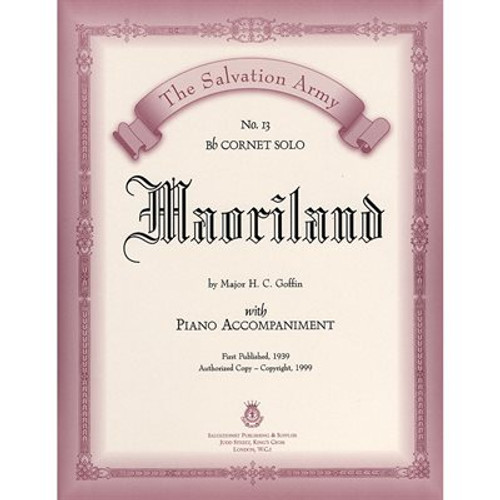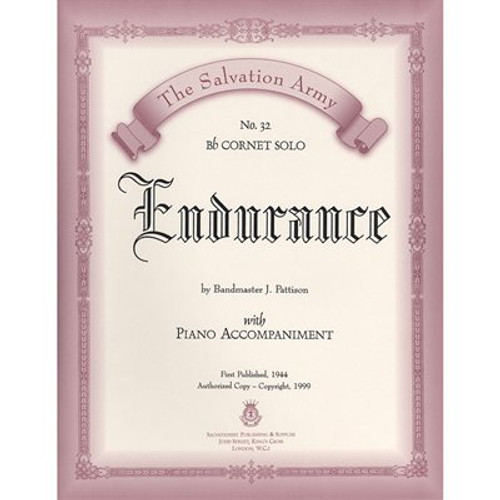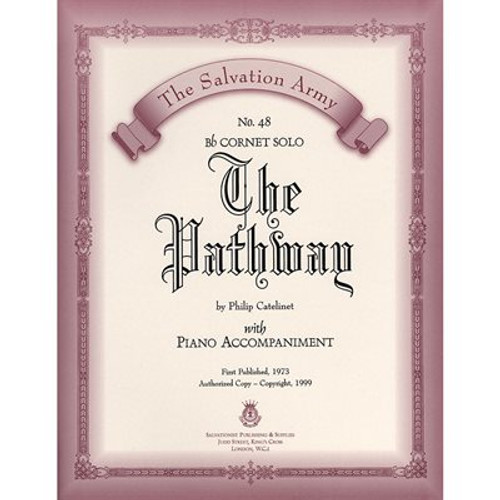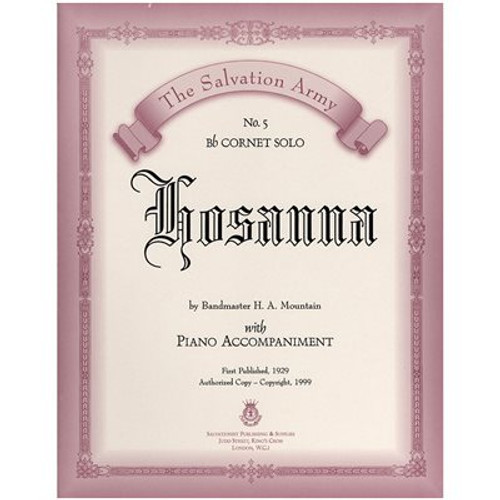Product Description
Caprice for Cornet
Solo
Composer: William Himes
Produced by The Salvation Army - Central Territory
Score Sample
NotesThis is a digital product. After purchasing you'll be able to download it from Account -> Orders -> Select order number
Score Notes
Notes:
This active and colorful accompaniment will certainly keep the band-especially percussionists - thoroughly involved from start to finish. The usual cautions for backing a soloist apply: players are encouraged to reduce in number whenever the soloist is in.
The opening should be flowing and ethereal in character, with a well-proportioned accelerando beginning at 44 reaching a bright allegro at bar 48. This sets the mood for the soloist's light-hearted entry at bar 54. (Think cartoon music!) At bar 137 the style becomes more dramatic before returning to the dream-like atmosphere of the opening.
Keep in mind the middle section (153-202) is quite bluesy, with players observing ""swing style"" throughout. The final section (203- end) revisits much of the previous melodic material, but this time with a 'Latin feel.' There should be no hint of swing here, with crisp execution of syncopated motifs, pressing on to a brilliant, fiery finish.
Program Note
In musical terms, a caprice is a light and whimsical work. In this case, the adjective ""youthful"" would also apply. This solo is dedicated to the memory of Joshua Olson, who at the age of twelve went to be with Jesus on February 3, 1999, having fought a courageous battle with Pseudo-obstruction Syndrome, a congenital disease that claims most within their first four years of life. For all the health challenges that were his, Josh lived a remarkably active life which included playing cornet in his corps youth band. His brief life was truly a testimony of faith.
Appropriately, the work is based on the chorus "I'm so happy" and the old gospel song, "Jesus is all the world to me," from which the final verse reads:
Jesus is all the world to me, I want no better friend;
I trust him now, I'll trust him when life's fleeting days shall end.
Beautiful life with such a friend, beautiful life that has no end;
Eternal life, eternal joy, he's my friend.
Program Note:
This colorful selection uses three songs of contrasting idiom to portray a progression of the human condition from despair to triumph:
Although this is a more extended work (approximate duration: 9:00), the inclusion of optional introductions and endings provides added usefulness of presenting singular performances of these three songs as follows:
Sometimes I feel like a motherless child: Beginning to optional ending at bars 39-40.
Reach out and touch: Bar 42 to optional ending at bars 110-113.
Storm the forts of darkness: Begin with snare drum roll (can be a pause) one beat before 117. Play to end as written.
Program Note:
This beautiful setting for solo trombones and band of the folk song O Waly, O Waly is often associated with the words of Isaac Watts:Note to the Conductor:
We are pleased to present this sensitive setting as it was initially conceived for solo trombone. Written for the Amsterdam Staff Band's 2005 tour of the United Kingdom, it was later adapted as a feature for trombone ensemble, at the request of Salvationist Publishing & Supplies, where it appears in 2009 as General Series 2059.
We are grateful to SP&S for kindly giving permission to publish this solo version in the American Festival Series. Of this work, the arranger, Olaf Ritman writes: "I consider this song my personal testimony."
Beginning to bar 12: The accompaniment, particularly at the opening and closing of the piece, is atmospheric, with suspended muted chords supporting the rubato trombone solo. The judicious use of percussion (chimes, bass drum and suspended cymbal) will add to the color and mood. Be sure to cue the chimes at bars 3 and 6.
at bar 4, a clear downbeat cure for the bass drum will help clarify tempo following the soloist's pause. Also give attention to the muted sforzando in cornets and trombones in bar 8.
Bars 13-52: Following the ritardando at bar 12, it is essential for the conductor to establish the correct tempo at bar 13, allowing the soloist lyrical freedom and the ability to sustain long phrases as the tune begins at bar 16. The descending scale gesture at bar 39 should be measured, yet not overstated.
Bars 53-74: There is a slight slowing of tempo as soprano, flugel and horns take the theme while cornets, trombones and euphonium adding countermelody.
Bars 75 to end: Returning to the opening tempo, it will again be helpful to give clear cues for the chimes, bass drum and triangle from bars 75 to the end.
[Note: This solo can be heard on the Chicago Staff Band recording,Kurios, performed by Brett Tolcher]
Program Note:
The tune Randolph, by preeminent English composer Ralph Vaughan Williams was first published in 1906 as a setting of Jeremiah Rankin's hymn, of which the first verse reads:
Note to the Conductor:
William Gordon's stunning four verse setting of Randolph progresses from the quiet simplicity of unison cornets and with each succeeding verse builds to a magnificent organ-like finale.
Gratitude is expressed to the publisher and copyright holder, Oxford University Press, for granting permission to publish this brass setting in the American Festival Series.
Beginning to bar 9: A ceremonial snare drum roll is the sole accompaniment to the cornets opening unison rendering of the tune.
Bar 10-17: The mellow instruments (flugel, horns, baritones and euphoniums) provide a beautiful change of color here with 2nd horn, baritones and euphonium seamlessly adding harmony.
Bars 18-26: A two beat snare and bass drum roll signals the entrance of the cornets and trombones in a more brilliant third verse setting. Here the bass trombone is essential (cued in Eb bass). Bring out the rising soprano cornet line from bar 22.
Bar 27 to end: A dramatic percussion roll precedes the "open pipes" organ like sounds of the final verse at bar 27. Be sure to observe the swell in bar 30, followed by a dramatic decrescendo before building to the final climatic chords. Avoid any tendency to overblow while striving for the full sonorities of this majestic finale.
[Note: this setting is especially effective when performed as a benediction "in the round" with players grouped by sections surrounding the audience.]








